Why Is This Issue Important to Congress?
The Army's Optionally Manned Fighting Vehicle (OMFV) is expected to be the third attempt to replace the M-2 Bradley Infantry Fighting Vehicle (IFV) which has been in service since the early 1980s. Despite numerous upgrades since its introduction, the Army contends the M-2 is near the end of its useful life and can no longer accommodate the types of upgrades needed for it to be effective on the modern battlefield.
Because the OMFV would be an important weapon system in the Army's Armored Brigade Combat Teams (ABCTs), Congress may be concerned with how the OMFV would impact the effectiveness of ground forces over the full spectrum of military operations. Moreover, Congress might also be concerned with how much more capable the OMFV is projected to be over the M-2 to ensure that it is not a costly marginal improvement over the current system. A number of past unsuccessful Army acquisition programs have served to heighten congressional oversight of Army programs, and the OMFV will likely be subject to a high degree of congressional interest. In addition to these primary concerns, how the Army plans to use the new congressionally-granted Section 804 Middle Tier Acquisition Authority as well as overall program affordability could be potential oversight issues for Congress.
The Next Generation Combat Vehicle (NGCV) Becomes the Optionally Manned Fighting Vehicle (OMFV)
In June 2018, the Army established the Next Generation Combat Vehicle (NGCV) program to replace the M-2 Bradley Infantry Fighting Vehicle (IFV), which has been in service since the early 1980s. In October 2018, Army leadership reportedly decided to redesignate the NGCV as the Optionally Manned Fighting Vehicle (OMFV) and add additional vehicle programs to what would be called the NGCV Program.1 Under the new NGCV Program, the following systems are planned for development:
- The Optionally Manned Fighting Vehicle (OMFV): the M-2 Bradley IFV replacement.
- The Armored Multi-Purpose Vehicle (AMPV):2 the M-113 vehicle replacement.
- Mobile Protected Firepower (MPF):3 a light tank for Infantry Brigade Combat Teams (IBCTs).
- Robotic Combat Vehicles (RCVs): three versions, Light, Medium, and Heavy.
- The Decisive Lethality Platform (DLP): the M-1 Abrams tank replacement.
Two programs—AMPV and MPF—are in Low Rate Initial Production (LRIP) and Prototype Development, respectively. Reportedly, the AMPV and MPF programs, which were overseen by Program Executive Office (PEO) Ground Combat Systems, will continue to be overseen by PEO Ground Combat Systems, but the NGCV Cross Functional Team (CFT) will determine their respective operational requirements and acquisition schedule.4
Report Focus on OMFV
Because AMPV and MPF are discussed in earlier CRS reports and the OMFV is in the early stages of development, the remainder of this report focuses on the OMFV and associated RCVs. Because the DLP is intended to replace the Army's second major ground combat system—the M-1 Abrams Tank—it will be addressed in a separate CRS report in the future.
Preliminary OMFV Requirements5
The Army's preliminary basic operational requirements for the OMFV include the following:
- Optionally manned. It must have the ability to conduct remotely controlled operations while the crew is off-platform.6
- Capacity. It should eventually operate with no more than two crewmen and possess sufficient volume under armor to carry at least six soldiers.
- Transportability. Two OMFVs should be transportable by one C-17 and be ready for combat within 15 minutes.
- Dense urban terrain operations and mobility. Platforms should include the ability to super elevate weapons and simultaneously engage threats using main gun and an independent weapons system.
- Protection. It must possess requisite protection to survive on the contemporary and future battlefield.
- Growth. It should possess sufficient size, weight, architecture, power, and cooling for automotive and electrical purposes to meet all platform needs and allow for preplanned product improvements.
- Lethality. It should apply immediate, precise, and decisively lethal extended range medium-caliber, directed energy, and missile fires in day/night/all-weather conditions, while moving and/or stationary against moving and/or stationary targets. The platform should allow for mounted, dismount, and unmanned system target handover.
- Embedded platform training. It should have embedded training systems that have interoperability with the Synthetic Training Environment.
- Sustainability. Industry should demonstrate innovations that achieve breakthroughs in power generation and management to obtain increased operational range and fuel efficiency, increased silent watch, part and component reliability, and significantly reduced sustainment burden.
Additional requirements include the capacity to accommodate7
- reactive armor,
- an Active Protection System (APS),
- artificial intelligence,8 and
- Directed-energy weapons9 and advanced target sensors.
Background
The Army's Current Infantry Fighting Vehicle (IFV)
The M-2 Bradley is an Infantry Fighting Vehicle (IFV) used to transport infantry on the battlefield and provide fire support to dismounted troops and suppress or destroy enemy fighting vehicles. The M-2 has a crew of three—commander, gunner, and driver—and carries seven fully equipped infantry soldiers. M-2 Bradley IFVs are primarily found in the Army's Armored Brigade Combat Teams (ABCT). The first M-2 prototypes were delivered to the Army in December 1978, and the first delivery of M-2s to units started in May 1981. The M-2 Bradley has been upgraded often since 1981, and the Army reportedly announced in January 2018 that it plans to undertake an upgrade to the M-2A5 version planned for the mid-2020s.10
M-2 Limitations and the Need for a Replacement
Despite numerous upgrades over its lifetime, the M-2 Bradley has what some consider a notable limitation. Although the M-2 Bradley can accommodate seven fully equipped infantry soldiers, infantry squads consist of nine soldiers. As a result, "each mechanized [ABCT] infantry platoon has to divide three squads between four Bradleys, meaning that all the members of a squad are not able to ride in the same vehicle."11 This limitation raises both command and control and employment challenges for Bradley-mounted infantry squads and platoons.
The M-2 Bradley first saw combat in 1991 in Operation Desert Storm, where its crews were generally satisfied with its performance.12 The M-2's service in 2003's Operation Iraqi Freedom (OIF) was also considered satisfactory. However, reports of vehicle and crew losses attributed to mines, improvised explosive devices (IEDs), and anti-tank rockets—despite the addition of reactive armor13 to the M-2—raised concerns about the survivability of the Bradley.14
Furthermore, the M-2 Bradley is reportedly reaching the technological limits of its capacity to accommodate new electronics, armor, and defense systems.15 By some accounts, M-2 Bradleys during OIF routinely had to turn off certain electronic systems to gain enough power for anti-roadside-bomb jammers. Moreover, current efforts to mount active protection systems (APS)16 on M-2 Bradleys to destroy incoming anti-tank rockets and missiles are proving difficult.17 Given its almost four decades of service, operational limitations, demonstrated combat vulnerabilities, and difficulties in upgrading current models, the M-2 Bradley is arguably a candidate for replacement.
Past Attempts to Replace the M-2 Bradley IFV
The Army has twice attempted to replace the M-2 Bradley IFV—first as part of the Future Combat System (FCS) Program,18 which was cancelled by the Secretary of Defense in 2009, and second with the Ground Combat Vehicle (GCV) Program,19 cancelled by the Secretary of Defense in 2014. These cancellations, along with a series of high-profile studies, such as the 2011 Decker-Wagner Army Acquisition Review, have led many to call into question the Army's ability to develop and field ground combat systems.
Why the FCS and GCV Programs Were Cancelled
FCS
Introduced in 1999 by Army Chief of Staff General Eric Shinseki, FCS was envisioned as a family of networked, manned and unmanned vehicles, and aircraft for the future battlefield. The Army believed that advanced sensor technology would result in total battlefield awareness, permitting the development of lesser-armored combat vehicles and the ability to engage and destroy targets beyond the line-of-sight. However, a variety of factors led to the program's cancellation, including a complicated, industry-led management approach; the failure of a number of critical technologies to perform as envisioned; and frequently changing requirements from Army leadership—all of which resulted in program costs increasing by 25%.20 After $21.4 billion already spent21 and the program only in the preproduction phase, then Secretary Gates restructured the program in 2009, effectively cancelling it.22
GCV23
Recognizing the need to replace the M-2 Bradley, as part of the FCS "restructuring," the Army was directed by the Secretary of Defense in 2009 to develop a ground combat vehicle (GCV) that would be relevant across the entire spectrum of Army operations, incorporating combat lessons learned in Iraq and Afghanistan. In 2010, the Army, in conjunction with the Pentagon's acquisition office, conducted a review of the GCV program to "review GCV core elements including acquisition strategy, vehicle capabilities, operational needs, program schedule, cost performance, and technological specifications." This review found that the GCV relied on too many immature technologies, had too many performance requirements, and was required by Army leadership to have too many capabilities to make it affordable. In February 2014, the Army recommended terminating the GCV program and redirecting the funds toward developing a next-generation platform.24 The cost of GCV cancellation was estimated at $1.5 billion.25
After the Ground Combat Vehicle (GCV): The Next Generation Combat Vehicle (NGCV) Program
In the aftermath of the GCV program, the Army embarked on a Future Fighting Vehicle (FFV) effort in 2015. Army officials—described as "cautious" and "in no hurry to initiate an infantry fighting vehicle program"—instead initiated industry studies to "understand the trade space before leaping into a new program."26 In general, Army combat vehicle modernization efforts post-FCS have been characterized as upgrading existing platforms as opposed to developing new systems. This was due in part to reluctance of senior Army leadership, but also to significant budgetary restrictions imposed on the Army during this period. Some in Congress, however, were not pleased with the slow pace of Army modernization, reportedly noting the Army was "woefully behind on modernization" and was "essentially organized and equipped as it was in the 1980s."27 In June 2018, in part due to congressional concerns, the Army announced a new modernization strategy and designated NGCVs as the second of its six modernization priorities.28 Originally, the NGCV was considered the program to replace the M-2 Bradley. Development of the NGCV would be managed by the Program Executive Officer (PEO) Ground Combat Systems, under the Assistant Secretary of the Army (ASA), Acquisition, Logistics, and Technology (ALT).
Army Futures Command (AFC) and Cross-Functional Teams (CFTs)
Army Futures Command29
In November 2017, the Army established a Modernization Task Force to examine the options for establishing an Army Futures Command (AFC) that would establish unity of command and effort as the Army consolidated its modernization process under one roof. Formerly, Army modernization activities were primarily spread among Forces Command (FORSCOM), Training and Doctrine Command (TRADOC), Army Materiel Command (AMC), Army Test and Evaluation Command (ATEC), and the Army Deputy Chief of Staff G-8.30 Intended to be a 4-star headquarters largely drawn from existing Army commands, AFC was planned to be established in an urban environment with ready access to academic, technological, and industrial expertise. On July 13, 2018, the Army announced that AFC would be headquartered in Austin, TX, and that it had achieved initial operating capability on July 1, 2018. According to the Army, when AFC reaches full operating capacity in summer 2019, the headquarters will comprise approximately 500 personnel (about 100 uniformed and 400 Army civilians). Sub-organizations, many of which currently reside within FORSCOM, TRADOC, and AMC, are to transition to AFC, but there are no plans to physically move units or personnel from these commands at the present time.
Cross-Functional Teams (CFTs)
Army Futures Command intends to use what it calls Cross-Functional Teams (CFT) as part of its mission, which includes the development of NGCV. As a means to "increase the efficiency of its requirements and technology development efforts, the Army established cross-functional team pilots for modernization" in October 2017.31 These CFTs are intended to
- leverage expertise from industry and academia;
- identify ways to use experimentation, prototyping, and demonstrations; and
- Identify opportunities to improve the efficiency of requirements development and the overall defense systems acquisition process.32
The eight CFTs are
- Long Range Precision Fires at Ft. Sill, OK;
- Next Generation Combat Vehicle at Detroit Arsenal, MI;
- Future Vertical Lift at Redstone Arsenal, AL;
- Network Command, Control, Communication, and Intelligence at Aberdeen Proving Ground, MD;
- Assured Positioning, Navigation and Timing at Redstone Arsenal, AL;
- Air and Missile Defense at Ft. Sill, OK;
- Soldier Lethality at Ft. Benning, GA; and
- Synthetic Training Environment in Orlando, FL.33
CFTs are to be a part of AFC. Regarding the NGCV, program acquisition authority is derived from Assistant Secretary of the Army (ASA) for Acquisition, Logistics, and Technology (ALT), who is also the senior Army Acquisition Executive (AAE), to whom the Program Executive Officers (PEOs) report. AFC is to be responsible for requirements and to support PEOs. The NGCV Program Manager (PM), who is subordinate to PEO Ground Combat Systems, is to remain under the control of ASA (ALT) but are to be teamed with CFTs under control of the AFC.34 The Government Accountability Office (GAO) notes, however
Army Futures Command has not yet established policies and procedures detailing how it will execute its assigned mission, roles, and responsibilities. For example, we found that it is not yet clear how Army Futures Command will coordinate its responsibilities with existing acquisition organizations within the Army that do not directly report to it. One such organization is the Office of the Assistant Secretary of the Army for Acquisition, Logistics and Technology [ASA (ALT)]—the civilian authority responsible for the overall supervision of acquisition matters for the Army—and the acquisition offices it oversees.35
The Army's explanation of how the NGCV program is to be administered and managed, along with GAO's findings regarding AFC not yet having established policies and procedures, suggests a current degree of uncertainty as to how the NGCV program will be managed.
Army's OMFV Acquisition Approach36
Figure 1 depicts the Department of Defense (DOD) Systems Acquisition Framework, which illustrates the various phases of systems development and acquisitions and is applicable to the procurement of Army ground combat systems.
 |
|
Source: http://acqnotes.com/acqnote/acquisitions/acquisition-process-overview, accessed February 13, 2019. Notes: Each phase of the acquisition process has specific DOD regulations and federal statutes that must be met. At the end of each phase, there is a Milestone Review (A, B, C) to determine if the acquisition program has met these required regulations and statues to continue on into the next phase. Critical Development Document (CDD): The CDD specifies the operational requirements for the system that will deliver the capability that meets operational performance criteria specified in the Initial Capabilities Document (ICD). Preliminary Design Review (PDR): The PDR is a technical assessment that establishes the Allocated Baseline of a system to ensure a system is operationally effective. Request for Proposal (RFP): A RFP is a document that solicits proposal, often made through a bidding process, by an agency or company interested in procurement of a commodity, service, or valuable asset, to potential suppliers to submit business proposals. Critical Design Review (CDR): A CDR is a multi-disciplined technical review to ensure that a system can proceed into fabrication, demonstration, and test and can meet stated performance requirements within cost, schedule, and risk. Production Readiness Review (PRR): The PRR assesses a program to determine if the design is ready for production. |
Original OMFV Acquisition Plan
Reportedly, the original OMFV plan called for five years of Technology Development, starting in FY2019, and leading up to a FY2024 Milestone B decision to move the program into the Engineering and Manufacturing Development phase.37 If the Engineering and Manufacturing Development phase proved successful, the Army planned for a Milestone C decision to move the program into the Production and Deployment phase in FY2028, with the intent of equipping the first unit by FY2032.38
Secretary of the Army Accelerates the Program
In April 2018, Secretary of the Army Mark Esper, noting that industry could deliver OMFV prototypes by FY2021, reportedly stated he wanted to accelerate the OMFV timeline.39 After examining a number of possible courses of action, the Army reportedly settled on a timeline that would result in an FY2026 fielding of the OMFV.40 This being the case, the Army reportedly will pursue a "heavily modified off-the-shelf model meaning a mature chassis and turret integrated with new sensors."41 Unofficially, some Army officials suggested they would like to see a 50 mm cannon on industry-proposed vehicles.42 Under this new acquisition approach, the Army plans to
- award up to two vendors three-year Engineering and Manufacturing Development (EMD) contracts in the first quarter of FY2020;
- if EMD is successful, make a Milestone C decision to move the program into the Production and Development phase in the third quarter of FY2023; and
- Equip first units in the first quarter of FY2026.43
Potential OMFV Candidates
Reportedly, the Army plans eventually to award a production contract for up to 3,590 OMFVs to a single vendor.44 Although the Army reportedly expects five to seven vendors to compete for the OMFV EMD contract, three vendors have already showcased prospective platforms.45
BAE Systems
BAE Systems is proposing its fifth-generation CV-90. The CV-90 was first fielded in Europe in the 1990s. The latest version mounts a 35 mm cannon provided by Northrop Grumman that can accommodate 50 mm munitions. The CV-90 also features the Israeli IMI Systems Iron Fist active protection system (APS), which is currently being tested on the M-2 Bradley. The CV-90 can accommodate a three-person crew and five infantry soldiers.
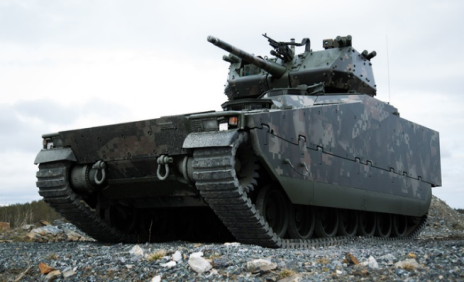 |
|
Source: https://www.baesystems.com/en-us/product/cv90, accessed January 31, 2019. |
General Dynamics Land Systems (GDLS)
GDLS is proposing its Griffin III technology demonstrator, which uses the British Ajax scout vehicle chassis. The Griffin III mounts a 50 mm cannon and can accommodate an APS and host unmanned aerial vehicles (UAVs). The Griffin II can accommodate a two-person crew and six infantry soldiers.
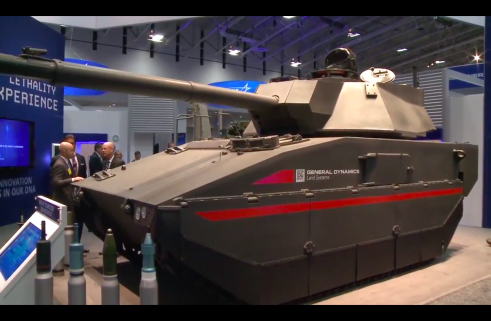 |
|
Source: Sydney J. Freedberg, "General Dynamics Land Systems Griffin III for U.S. Army's Next Generation Combat Vehicle (NGCV)," October 8, 2018. |
Raytheon/Rheinmetall
Raytheon/Rheinmetall is proposing its Lynx vehicle. It can mount a 50 mm cannon and thermal sights, and can accommodate both APS and UAVs. Raytheon states that the Lynx can accommodate an entire nine-soldier infantry squad.46
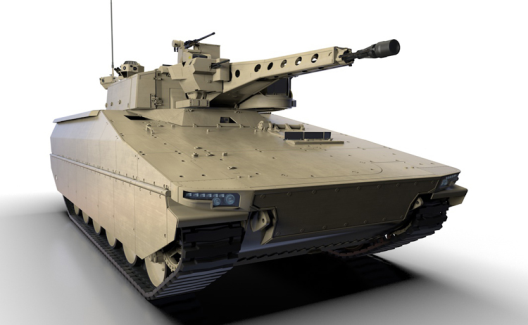 |
|
Source: https://www.rheinmetall-defence.com/en/rheinmetall_defence/systems_and_products/vehicle_systems/armoured_tracked_vehicles/lynx/index.php, accessed January 31, 2019. |
Robotic Combat Vehicles (RCVs) and the OMFV
As part of the revised NGCV Program, the Army plans to develop three RCV variants: Light, Medium, and Heavy. The Army reportedly envisions employing RCVs as "scouts" and "escorts" for manned OMFVs.47 RCVs could precede OMFVs into battle to deter ambushes and could be used to guard the flanks of OMFV formations.48 Initially, RCVs would be controlled by operators riding in NGCVs, but the Army hopes that improved ground navigation technology and artificial intelligence will permit a single operator to control multiple RCVs.49 The following sections provide a brief overview of each variant.50
Robotic Combat Vehicle–Light (RCV–L)
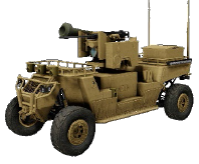 |
|
Source: The Army's Robotic Combat Vehicle Campaign Plan, January 16, 2019. |
The RCV–L is to be less than 10 tons, with a single vehicle capable of being transported by rotary wing assets. It should be able to accommodate an anti-tank guided missile (ATGM) or a recoilless weapon. It is also expected to have a robust sensor package and be capable of integration with UAVs. The RCV–L is considered to be "expendable."
Robotic Combat Vehicle–Medium (RCV–M)
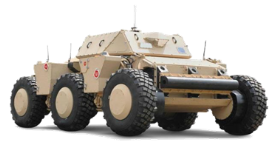 |
|
Source: The Army's Robotic Combat Vehicle Campaign Plan, January 16, 2019. |
The RCV–M is to be between 10 to 20 tons, with a single vehicle capable of being transported by a C-130 aircraft. It should be able to accommodate multiple ATGMs, a medium cannon, or a large recoilless cannon. It is also expected to have a robust sensor package and be capable of integration with UAVs. The RCV–M is considered to be a "durable" system and more survivable than the RCV–L.
Robotic Combat Vehicle–Heavy (RCV–H)
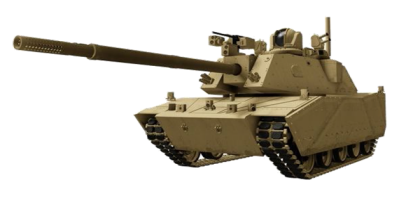 |
|
Source: The Army's Robotic Combat Vehicle Campaign Plan, January 16, 2019. |
The RC–H is to be between 20 to 30 tons, with two vehicles capable of being transported by a C-17 aircraft. It is also expected to be able to accommodate an onboard weapon system capable of destroying enemy IFVs and tanks. It should also have a robust sensor package and be capable of integration with UAVs. The RCV–H is considered to be a "nonexpendable" system and more survivable than the other RCVs.
RCV Acquisition Approach
Reportedly, the Army does not have a formal acquisition approach for the RCV, but it plans to experiment from FY2020 to FY2023 with human interface devices and reconnaissance and lethality technologies.51 Reportedly, the Army plans to issue prototype contracts in November 2019.52 Depending on the outcome of experimentation with prototypes, the Army expects a procurement decision in FY2023.53
OMFV, RCV, and Section 804 Middle Tier Acquisition Authority
Section 804 of the National Defense Authorization Act for FY2016 (P.L. 114-92) provides authority54 to the Department of Defense (DOD) to rapidly prototype and/or rapidly field capabilities outside the traditional acquisition system. Referred to as "804 Authority," it is intended to deliver a prototype capability in two to five years under two distinct pathways: Rapid Prototyping or Rapid Fielding. One of the benefits of using 804 Authority is that the services can bypass the Joint Requirements Oversight Council (JROC) and the Joint Capabilities Integration Development Systems (JCIDS), two oversight bodies that, according to some critics, slow the acquisition process.55 Under Rapid Prototyping, the objectives are to
- field a prototype that can be demonstrated in an operational environment, and
- Provide for residual operational capability within five years of an approved requirement.
Under Rapid Fielding, the objectives are to
- begin production within six months, and
- Complete fielding within five years of an approved requirement.
For the OMFV program, the Army reportedly plans to use Rapid Prototyping under Section 804 to permit the program to enter at the EMD Phase, thereby avoiding a two- to three-year Technical Maturation Phase.56 Regarding the RCV program, the Army's Robotic Campaign Plan indicates that Section 804 authority is an "option" for RCV development.57
Concerns with Section 804 Authority
While many in DOD have embraced the use of Section 804 authority, some have expressed concerns. Supporters of Section 804 authority contend that provides "an alternative path for systems that can be fielded within five years or use proven technologies to upgrade existing systems while bypassing typical oversight bodies that are said to slow the acquisition process."58 Critics, however, argue that "new rapid prototyping authorities won't eliminate the complexities of technology development."59 One former Under Secretary of Defense for Acquisition, Technology, and Logistics, Frank Kendall, reportedly warns
What determines how long a development program takes is the product. Complexity and technical difficulty drive schedule. That can't be wished away. Requirements set by operators drive both complexity and technical difficulty. You have to begin there. It is possible to build some kinds of prototypes quickly if requirements are reduced and designs are simplified. Whether an operator will want that product is another question. It's also possible to set totally unrealistic schedules and get industry to bid on them. There is a great deal of history that teaches us that this is a really bad idea.60
Others contend that for this authority to work as intended, "maintaining visibility of 804 prototyping would be vital to ensure the authority is properly used" and that "developing a data collection and analytical process will enable DOD to have insight into how these projects are being managed and executed."61 In this regard, congressional oversight of programs employing Section 804 authority could prove essential to ensuring a proper and prudent use of this congressionally authorized authority.
FY2020 OMFV and RCV Budget Request62
The Army requested $378 million in Research, Development, Test, and Evaluation (RDT&E) funding for the OMFV program and $109 million in RDT&E funding for the RCV in its FY2020 budget request. In terms of the OMFV, funding is planned to be used for, among other things, maturing technological upgrades for integration into the vehicle, including nondevelopmental active protection systems (APS), the XM 913 50 mm cannon, and the 3rd Generation Forward Looking Infrared Radar (FLIR). FY2020 funding for RCVs is planned for finishing building prototypes of surrogate platforms and conducting manned-unmanned teaming evaluations.
Potential Issues for Congress
How Will the OMFV Program Avoid the Same Fate as the Cancelled FCS and GCV Programs?
The OMFV is expected to be the Army's third attempt to replace the M-2 Bradley IFV after two costly previous attempts were cancelled, perhaps casting doubt on the Army's ability to design and field major ground combat systems. While many factors contributed to the cancelled FCS and GCV programs, two common problems were (1) overreliance on too many immature technologies, as well as the failure of some critical technologies, and (2) frequently changing performance requirements from Army leadership, resulting in increased program costs. Although the Army suggests that an emphasis on prototyping and the creation of the Army Futures Command (AFC) may remedy such problems, it can be argued these remedies are, at best, too general and lack specific measures necessary to ensure that past problems do not recur. To enhance program oversight and avoid potential problems in the OMFV program, Congress might consider requiring the Army to articulate the specific measures it will employ to mitigate technological challenges and leadership-generated "requirements creep." In terms of requirements, it may be beneficial to have answers to the following questions:
- Who in the Army will have input into OMFV performance requirements?
- Who in the Army adjudicates the inputs for OMFV performance requirements?
- Who in the Army will be responsible for the final decision on OMFV performance requirements?
Understanding these standards could help policymakers conduct oversight in terms of overall OMFV program accountability, especially if requirements change over the lifecycle of the program.
Army Futures Command's (AFC's) Role in OMFV and RCV Program Management
One of the reasons cited for the failure of the FCS program was a "complicated program management approach."63 Program management of major defense systems typically involves a number of organizations and multiple authorities and processes. Even by those standards, however, program management of the OMFV and RCV programs is arguably overly complicated and somewhat ill-defined (see pages 6-7). Determining AFC's role in OMFV and RCV program management, and how it will relate to the ASA (ALT) and PEO Ground Combat Systems and other organizations, may be a work in progress; however, at some point, having a clearly established management structure with agreed authorities and responsibilities is likely to be essential for ultimate program success. Toward this end, Congress might consider examining, in detail, the Army's proposed program management structure and authorities and processes for OMFV and RCV to help ensure that program management will be efficient and effective, and not a programmatic detriment (as it was in the case of the FCS).
The Relationship Between the OMFV and RCVs
As previously noted, the Army envisions employing RCVs as "scouts" and "escorts" for manned OMFVs. In addition to enhancing OMFV survivability, RCVs could potentially increase the overall lethality of ABCTs. Army leadership has stated that the Army's first priority is replacing the Bradley with the OMFV, that the RCV will mature on a longer timeline than the OMFV, and that the OMFV will later be joined by the RCV.64
Given technological challenges, particularly autonomous ground navigation and artificial intelligence improvement,65 the Army's vision for RCV may not be achievable by the planned FY2026 fielding date or for many years thereafter. The Army describes the OMFV and RCV as "complementary" systems,66 but a more nuanced description of both the systematic and operational relationship between the two could be beneficial. While the OMFV appears to offer a significant improvement over the M-2 Bradley—given weapon systems technological advances by potential adversaries—operating alone without accompanying RCVs, the OMFV may offer little or marginal operational improvement over the M-2 Bradley. Recognizing the risks associated with a scenario where RCV fielding is significantly delayed or postponed due to technological challenges—along with a better understanding of the systematic and operational relationship between the OMFV and the RCV—could prove useful for policymakers. Another potential oversight question for Congress could be what is the role of Army Futures Command (AFC) in integrating requirements between OMFV and RCVs?
Section 804 Authority and the OMFV
To some, the use of Section 804 authority offers great promise in developing and fielding qualifying weapon systems quickly and cost-effectively. Others note that rapid prototyping authorities under Section 804 will not eliminate the complexities of technology development and that operational requirements also drive the complexity and technical difficulty of a project. In acknowledging the potential benefits that Section 804 authority could bring to the Army's third attempt to replace the M-2 Bradley, as well as the risks associated with its use over a more traditional acquisition approach, policymakers might decide to examine the potential costs, benefits, and risks associated with using Section 804 authority for the OMFV program.